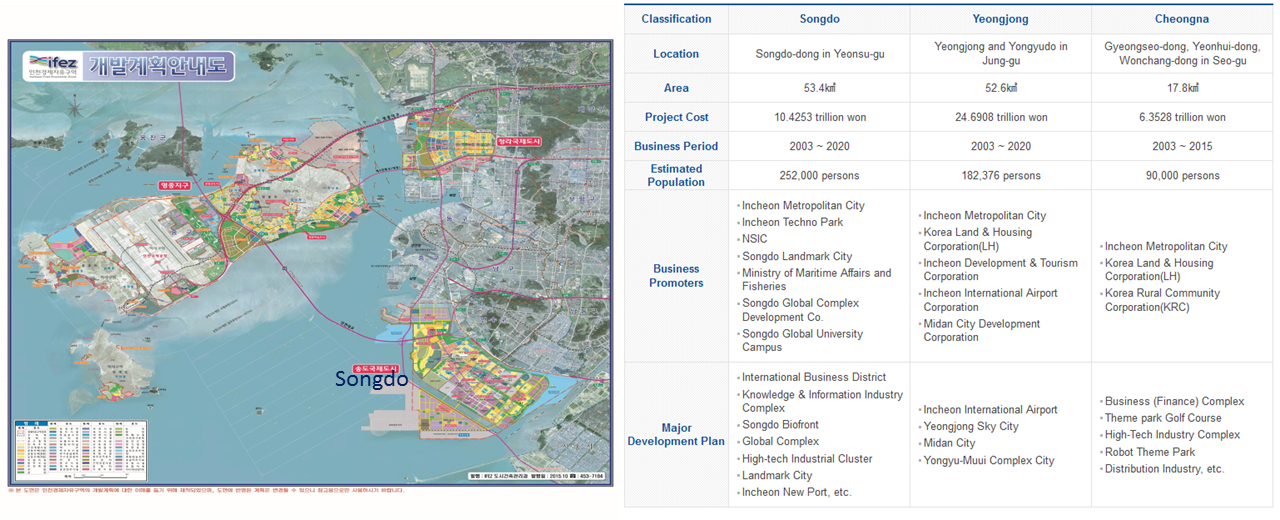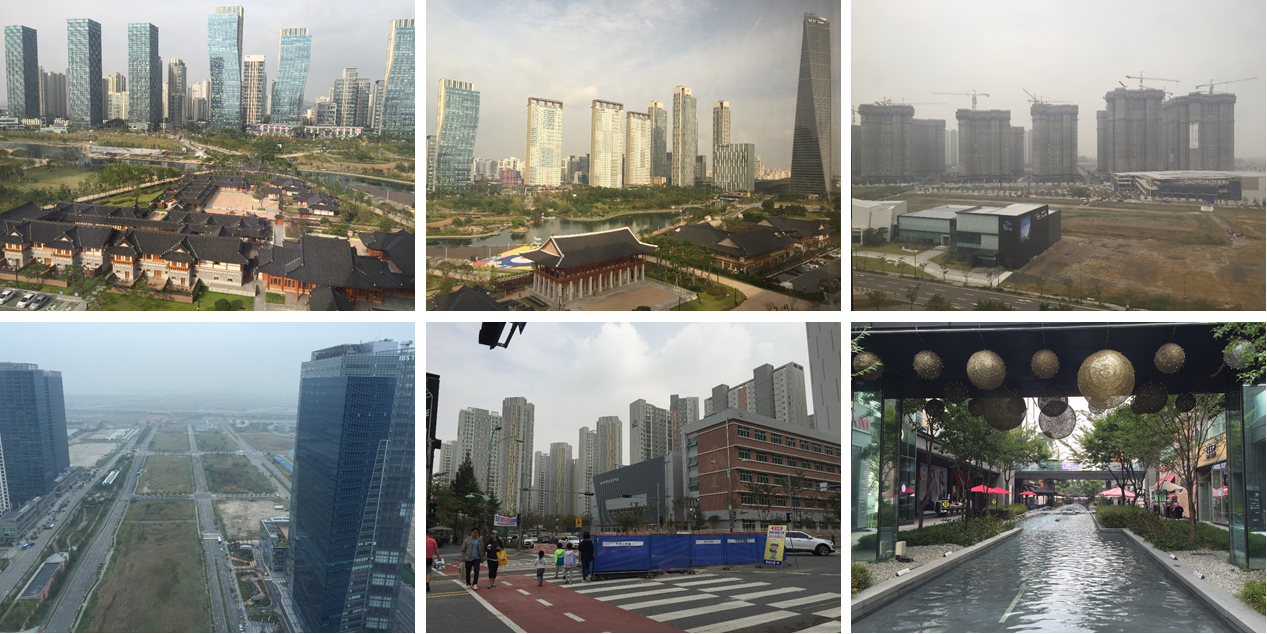On September 30th/October 1st, while on a trip to South Korea, I visited Songdo, the much discussed smart city development built in the Incheon Free Economic Zone (IFEZ) at the edge of the Seoul metropolitan area. The IFEZ, initiated in 2003, consists of three large-scale developments – Songdo (international business district, with a focus on research, education, bio-tech, conferencing), Yeongjong (aviation and logistics hub, tourism), and Cheongna (finance, component manufacturing, robotics, shopping and tourism), much of it built on reclaimed land.
My exploration mainly consisted of a long wander around Songdo and a visit to the IFEZ Promotion Centre on 33rd floor of G-tower. Unfortunately, the exhibition in the Compact Smart City museum was ‘closed for construction’ and I also failed to see the U-City Vision at Tomorrow City as the entire complex seemed to be closed (I have a feeling that it might be permanently closed as the website was last updated in May 2010).
While Songdo is perhaps best known in the urban studies literature as model smart city and an example of testbed urbanism on a grand scale, my sense is that its creation really has to be contextualised with respect to IFEZ as it is predominately an economic development initiative aimed at driving domestic growth and establishing South Korea as a North East Asian hub for particular industries and thus consolidating its position as a key player in the global economy.
Seen from this perspective, the focus on creating a smart city is an implementation strategy designed to attract investment capital, anchor tenants, and global workers, with a side benefit of creating a potential exportable model of development. Indeed, the smart city is one of four such implementation strategies used by IFEZ to bring the vision of being a ‘global business frontier’ to life, the others being: creating ‘a global economic platform’, becoming a ‘hub of service industries’ and a ‘hub of convergence’.
These strategies have been quite successful in attracting Korean and global investment, with over $US 8.3 billion being invested in the IFEZ by June 2016. This has led to rapid growth. In 2003 the population of the IFEZ (3 areas) was 25,778; by June 2016 it stood at 253,465. Of these, 4,281 were international residents. Songdo’s population exceed 100,000 in early 2016. In the same period the number of companies operating in the IFEZ had grown to 1,737, of which 80 were foreign-owned, and there were 4 international universities and 14 international organizations who had opened campuses/offices in the IFEZ, including branches of the United Nations. The plan is that by 2030 investment will have reached $US 15 billion, the number of foreign invested companies will have reached 150, the number of international organizations 150, the number of international universities 10, and the population will have grown to 536,000, of which 60,000 will be international residents.
To aid such growth, the IFEZ has a number of development, planning and social policies. For example, each district has their own design theme, with Songdo specializing in ‘night landscape, high end architecture landscape, mountainous skyline and waterside network’, along with the theme of being a smart city, or what they have termed ‘U-City’, an intelligent city that utilizes ubiquitous computing to manage urban infrastructures and city services. In the IFEZ case, the U-City seeks to provide the coordinated management of transportation, environment, crime prevention, fire prevention, and facility management in an integrated manner across the three areas from a single control room. In terms of social policies this includes trying to produce a ‘trouble free life for foreign residents’, including a ‘real-estate investment immigration system’, in which non-Korean investors are given resident status and after five years permanent residence status.
Recently they have established a plan to develop the IFEZ U-City model into what they term ‘the K-Smart City model’ to ‘more aggressively reinforce its presence in the overseas market.’ Utilising a public cloud system to ‘to securely store the massive amount of information flowing in from the CCTVs and sensors installed across the city’ and an approach to ‘drastically reducing construction and maintenance costs’, this model, it is anticipated, will not only ‘enhance the quality of life of citizens but also serve as a new growth engine as an added-value industry.’ In other words, the IFEZ wants to firmly establish itself as a model of smart city development and governance and to export this model, their expertise and new technologies globally, as made clear by Government official Kim Jong-won of the IFEZ U-City Division: “We plan to develop the knowhow, technology, and expertise regarding the construction of IFEZ and U-City into a brand and commercialize it on a global level.” Songdo is thus a means to showcase top-tier infrastructure and to create an exportable set of knowledges and technologies.
So, what were my impressions of the Songdo? Having been led to believe that the place is half-built and mostly empty, it is clear that while one section is under-construction a substantial chunk is complete and occupied and all the major infrastructure (in terms of roads, rail, air, energy) are in place. The part that is complete while quite quiet during the day is reasonably busy during the night with lots of people on the street and in the park, loads of kids playing in courtyards of tower blocks, and there are hundreds of restaurants and shops. As the empty lots attest it’s a project in development, but far from being a ghost town. Indeed, 13 years ago there was little but reclaimed land, but now there are over 100,000 people living in Songdo and in the areas that are complete the built environment feels relatively mature.
However, my sense was that it’s all very new, clean and wealthy, and there was little organic about the city – it has clearly been planned and developed to a masterplan, with centrally managed clustering of shops, restaurants and services, and some signature architecture around Central Park. Moreover, the nascent city is a gated community at city-scale. Given that the land was reclaimed there was no local community to displace and the cost of living in the private apartment buildings works to exclude lower-income households. Indeed, Songdo is reputed to be one of the largest privately developed and financed urban developments globally and it aims for a certain degree of exclusivity that will attract additional international investment.
As for the smart city technologies these are difficult to spot, which is no surprise given they are designed to work in the background. As such, the place does not particularly feel very smart (but rather a newly constructed city district) and since I struggled to get online outside the hotel I couldn’t access what information is made publicly available. Moreover, what is highlighted in the Promotions Centre might have been pushing the smart city envelope in the mid-2000s but is now pretty middle of the road (real-time passenger information, sensor networks and CCTV, smart parking, traffic and accident information, e-government services, energy-efficient buildings, urban control room).
My overall impression then is that Songdo is more about economic development, free trade, global capitalism, real-estate development, cities as a target market for tech development, and gated community at a city scale, than it is about creating sustainable, diverse and smart communities and citizens. And despite the global financial crisis it’s making a pretty good fist of the former, having now seemingly gained enough critical mass in terms of investment, infrastructure, companies and population to become an urban growth machine. I’m not convinced, however, that this is the kind of smart city that other places should seek to emulate given it’s the vision of private interests largely for the benefit of private interests.
Rob Kitchin
A number of the quotes in this blog post are from the IFEZ journal (Sept/Oct 2016, vol 71).
Post-script – I’ve had a search around after I posted this piece. There are a number of academic articles/book chapters concerning the development of Songdo, including:
Carvalho, L. (2012) Urban competiveness, U-city strategies and the development of technological niches in Songdo, South Korea. In Bulu, M. (ed) City competitiveness and improving urban subsystems. Information Science Reference, Hershey, PA. pp. 197-216.
Halpern, O., LeCavalier, J., Calvillo, N. and Pietsch, W. (2013) Test-Bed Urbanism. Popular Culture 25(2): 272-306.
Kuecker, G.D. (2013) Building the Bridge to the Future: New Songdo City from a Critical Urbanism Perspective. Paper prepared for the workshop: New Songdo City and South Korea’s Green Economy: An Uncertain Future.
Kim, J.I. (2014) Making cities global: the new city development of Songdo, Yujiapu and Lingang. Planning Perspectives 29(3): 329-356
Kim, C. (2010) Place promotion and symbolic characterization of New Songdo City, South Korea. Cities 27(1): 13-19.
Shin, H., Park, S.H. and Sonn, J.W. (2015) The emergence of a multiscalar growth regime and scalar tension: the politics of urban development in Songdo New City, South Korea. Environment and Planning C 33(6): 1618-1638
Shwayri, S.T. (2013) A Model Korean Ubiquitous Eco-City? The Politics of Making Songdo. Journal of Urban Technology 20(1): 39-55.



